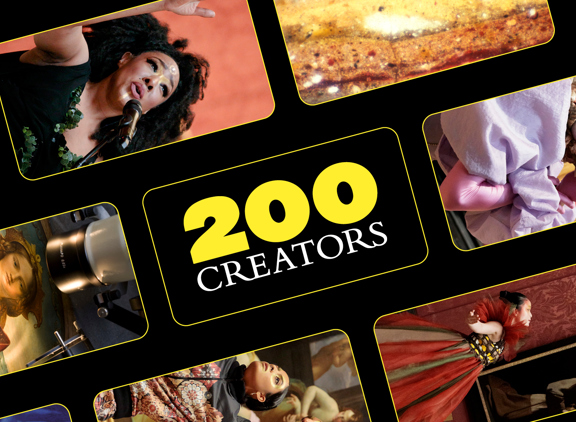One of my core memories of the National Gallery is getting told off.
Our secondary school class had been packed onto a coach in the Black Country, driven down the M6 and unloaded into its grand rooms of big horse paintings and domed ceilings.
It was at one of these domed ceilings I had the audacity to point my digital camera, resulting in a swift rebuke from a security guard.
Fast forward a couple of decades, and the National Gallery not only still allows people from the Black Country through the doors – it also allows you to take pictures. And this year they invited 20 content creators specifically to take videos inside the gallery to publish on the internet.
We’ve come a long way.
So my content of the week is in recognition of that positive change: it’s the 200 Creators Network.
It does what it says on the tin: it’s a network of 200 content creators as well as 20 Creative Collaborators in support of the gallery’s 200th anniversary celebrations.
Their social media manager Ellie Wyant kindly agreed to chat to me about it and – because I’m a museum nerd – the following will be a deep dive into how a programme like this is planned, carried out and what it means for the sector.
It’s 1592 words long. You’ve been warned.

The National Gallery isn’t the UK’s oldest purpose-built public gallery – that honour goes to Dulwich Picture Gallery – but the 200th anniversary is still a Big Deal.
While planning for the Big Deal, it was Senior Content Planner John Shevlin who first suggested creating a network of content creators. He then went off to work for the Royal Academy of Arts, and so Social Media Manager Ellie Wyant developed and delivered the programme, alongside Beks Leary, their new Senior Content Planner; Lawrence Chiles, Head of Digital; Tracy Jones, Head of Communications; Lucy Allen, Senior Programme Manager; and Charlotte Booth, Senior Solicitor for the Gallery.
The task was daunting. If I was in Ellie’s shoes, I would be inwardly and outwardly screaming: how do we get 200 people to agree to work with us? What if nobody’s interested? How are we going to have time to plan, create and publish content with 20 collaborators?
So it was comforting to hear that even Ellie, with a decade of experience at a national institution, had a knot in her stomach for the 3 years it took to plan and pull it off.
This is how they did it
Money helps.
Bloomberg Philanthropies came onboard as overall digital partner funding four main digital projects for the anniversary, and it allowed the National Gallery to pay the 20 collaborators market rate (£4000).
But, as the point of the project was to reach different audiences, the team also wanted a broad range of content creators rather than a load of art historians. So, working with the agency Fetch Friends, they put out a call through the press, social media, paid ads and reached out directly to agencies.
And people responded.
50 long-listed creators came down for an Ideas Lab Event at the National Gallery – a process the Gallery has tried and tested through its NGX innovation programme – where they could explore the galleries out-of-hours with a dozen or so staff from their Archive, Scientific, Learning and Curatorial teams.
Speaking as someone who’s struggled to get staff involved with social media, this is impressive. But this culture of collaboration is obvious if you’ve seen any of the National Gallery’s previous content, which by featuring voices from across (and without) the gallery fulfils what I think is one of social media’s main purposes: being a window onto the whole organisation. What helps is that taking digital content seriously is also driven from the top by Director Gabriele Finaldi, who first made Digital its own directorate.
It’s easy to forget that when a lot of people think about museums and galleries they think of their reputation, their cultural clout and the big intimidating buildings with lots of grecian pillars. It takes an event like this to make people realise that museums and galleries are actually composed of nice people who happen to work in big intimidating buildings with lots of grecian pillars.
For a lot of creators it was their first time visiting the National Gallery – and while some remarked feeling intimidated, they were also surprised just how friendly and inviting both the staff and the space could be.
After the Lab Event each creator was asked to make a 500-word pitch. These were then whittled down to 20 finalists signed off by a cross-organisational panel and then by the Director. Each creator was given the option of making a 10-minute YouTube video and Short, an Instagram Reel and set of Stories, or three TikTok videos. In the end only two people went for the YouTube option.
With the content signed off, then came the mammoth task of fitting all 20 of them into the galleries, out-of-hours, to film, review and publish – all two months before the actual 200th anniversary.
Pretty much all of them filmed on their phones, with staff pitching in to help with filming or answer questions, but otherwise letting the creators take the lead. It all culminated in an event in July 2024, which was also the official launch of the 200 Creators network.
The content was then gradually posted both by the National Gallery and, after a gap, by the creators themselves. There was a conscious choice not to use the collab posting function on Instagram, and doing so didn’t seem to affect performance of the posts.
The results
The content itself is a case study in how to find different routes into a collection.
They had Rosie Harte talking about clothing in paintings, Alice Loxton exploring the conservation studio, Zack Pinsent recreating the suit from Gainsborough’s ‘Mr Hallett’, Christian Brighty continuing his episodic period drama within the galleries, and – well, you get the idea. 16 more videos like that. Go to their Instagram and see for yourself.
This diversity is down to the National Gallery giving the creators free rein, but it’s also the point. The gallery and its collections is for the nation, but that doesn’t mean everyone identifies with or feels welcome by the gallery. This project was about raising wider awareness, reaching people and making new points of relevance. 200 Creators helped reach those wider audiences, and made more relevant by presenting the National Gallery in a much more playful, forward-thinking light.
Interestingly, Ellie is reluctant to assign hard targets to social media – there’s too much ‘pot luck’. There was, however, a target for the wider anniversary celebrations which I am reassured was “smashed”.
So how does this help me
Now, when I spoke to Ellie she was conscious that this is a project that was funded externally by Bloomberg Philanthropies, that they’re the National Gallery and their staff are fully on-board with social media engagement.
But still, she had some tips for anyone considering working with content creators:
- Be obsessively online. Knowing what is landing and not landing on TikTok or Instagram Reels can give you a feel for where your gaps are, and how content creators could help.
- There is no wrong way to look at an artwork or object. Trust your content creators to find their hook.
- Give content creators space to explore your institution. You want their content to be authentic, so don’t ram your requirements down their throats.
- Don’t always go macro – micro content creators may have fewer followers, but those followers may be more relevant to you.
- Do an open event and invite people along. You’ll never know if you don’t try.
My 2¢
How do you solve a problem like: the authenticity and reactivity of content creator personalities are sometimes far more engaging to the public than faceless organisational social media?
One solution is making your social media manager that on-screen personality. But that’s not the job a lot of us signed up for.
When social media was much more text- and image-based, social media managers became used to being the editorial voice. With the dominance of video that is no longer always possible, and in a lot of cases shouldn’t be possible. If the National Gallery is for and of the nation, then the nation’s voices and interests should be represented.
So instead social media managers should manage, rather than star. That means using a diversity of voices and faces, all in concert and conducted by the social media manager. The institutional voice isn’t the only one that matters – so bring in the writers, poets, actors, musicians, staff, community members and content creators.
Maybe work with a local college or university and ask their students to have a crack at kicking off their content careers in the galleries. Make it part of your school programme. Ask local creators you admire how you can work together.
We can’t do that all the time of course. It costs money, and it takes time. But not every initiative needs to be at the level of the paid 20 content collaborators. There’s also the model of the National Gallery’s wider network, building an ongoing relationship with creators through free membership and exclusive access.
The content creator economy isn’t going anywhere. We should get involved before it leaves us in the dust.
Reach out
Interested in what I do and how I can help? Chatting to me is free, and I can work to your budget :)
